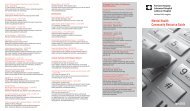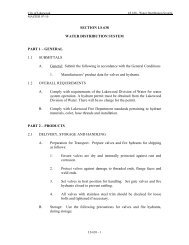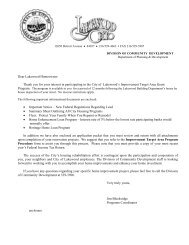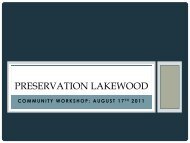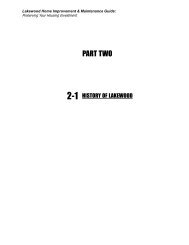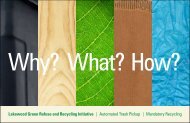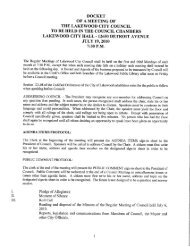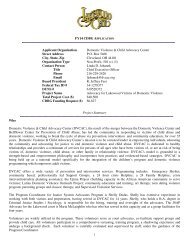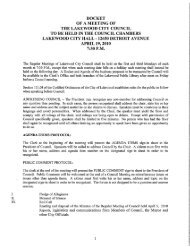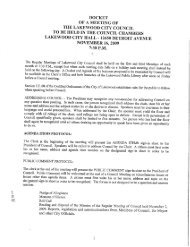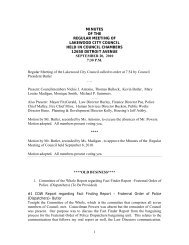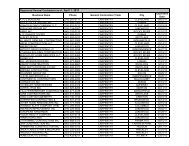INSTRUCTIONS FOR FORM L-1 - City of Lakewood, Ohio
INSTRUCTIONS FOR FORM L-1 - City of Lakewood, Ohio
INSTRUCTIONS FOR FORM L-1 - City of Lakewood, Ohio
You also want an ePaper? Increase the reach of your titles
YUMPU automatically turns print PDFs into web optimized ePapers that Google loves.
<strong>INSTRUCTIONS</strong> <strong>FOR</strong> <strong>FOR</strong>M L-1<br />
GENERAL <strong>INSTRUCTIONS</strong><br />
WHO MUST FILE -<br />
• All residents age 18 or older, unless exempt, that lived in <strong>Lakewood</strong> at any<br />
time during the tax year (January through December) whether or not this is<br />
a permanent home. If exempt, see Taxpayer Exemption below.<br />
• Residents or non-residents that have business including rental income<br />
(Schedule C and Schedule E filers only) in <strong>Lakewood</strong>. If you have a net loss<br />
you are still required to file a return.<br />
• Non-residents that worked in <strong>Lakewood</strong> and their employer did not withhold<br />
income tax.<br />
TAXPAYER AND/OR SPOUSE EXEMPTION - If are not required to pay city<br />
income tax - complete Table C, sign and date the return and mail to us before<br />
April 15th.<br />
DECEASED TAXPAYERS - If the taxpayer died before filing a return for the<br />
current tax year, the taxpayer’s spouse or personal representative may have to<br />
file and sign a return for the person who died. The person who files the return<br />
should write “DECEASED” and the date <strong>of</strong> death in the name and address<br />
portion <strong>of</strong> the tax return. When signing the tax return, write “DECEASED” in the<br />
space provided for the signature. Spouse should sign as “Surviving Spouse”<br />
and agent should sign as “Personal Representative.”<br />
WHEN & WHERE TO FILE - File as early as possible with the <strong>City</strong> <strong>of</strong><br />
<strong>Lakewood</strong> - Division <strong>of</strong> Municipal Income Tax Office located at 12805 Detroit<br />
Avenue, <strong>Lakewood</strong>, <strong>Ohio</strong> 44107 on or before April 15 following the close <strong>of</strong> the<br />
tax year. If the due date falls on a Saturday, Sunday, or legal holiday file by the<br />
next business day. Those persons owing tax who have not paid quarterly<br />
estimates equal to at least 90% <strong>of</strong> the tax due or paid an estimate equal to or<br />
exceeding 100% <strong>of</strong> the prior year tax due, should file this return by January 31<br />
to avoid penalty and interest charges.<br />
EXTENSION(S) OF TIME TO FILE - A federal extension will extend the<br />
municipal due date to the last day <strong>of</strong> the month to which the due date <strong>of</strong> the<br />
federal return is extended. A copy <strong>of</strong> the federal extension must be filed with<br />
the <strong>Lakewood</strong> Municipal Income Tax Office on or before the original due date<br />
for filing the return.<br />
METHOD OF PAYMENT - Checks or money orders should be made payable<br />
to CITY OF LAKEWOOD – DIVISION OF MUNICIPAL INCOME TAX. Amounts<br />
less than $1.00 need not be remitted. There will be a $30 charge for dishonored<br />
checks.<br />
MasterCard or Visa may be used for payment <strong>of</strong> municipal income tax. To<br />
charge the amount <strong>of</strong> tax due, complete the Pay By Credit Card - Mastercard /<br />
Visa box next to the signature box on the front <strong>of</strong> the tax return. The amount<br />
charged may be considered a cash advance with interest starting from<br />
date recorded.<br />
HEADING - Check pre-printed information. If not correct, make corrections by<br />
crossing out pre-printed information and entering correct data above the<br />
line(s). Add any missing items, such as your apartment number. If you don’t<br />
have a pre-printed form, print or type your name, address, and social security<br />
number in the space provided. If you are filing a joint return, print your<br />
spouse’s name and social security number.<br />
If you received a preprinted form from this <strong>of</strong>fice, be sure to file, even if you<br />
had no taxable income for the year. If you are no longer subject to <strong>Lakewood</strong><br />
tax, see the Taxpayer and/or Spouse Exemption section.<br />
AMENDED RETURN - If you are amending a tax year be sure to indicate the<br />
tax year that you are amending in the space provided. If you are amending<br />
your <strong>Lakewood</strong> return based upon an amended return that you filed with the<br />
I.R.S., you must include a copy <strong>of</strong> the amended Federal return, including any<br />
applicable schedules that pertain to the amendment. If you are filing an<br />
amended <strong>Lakewood</strong> return based upon an audit that the I.R.S. conducted, you<br />
must include documentation pertaining to the audit and note any changes that<br />
were made by the I.R.S. to reduce or increase your taxable income.<br />
GENERAL <strong>INSTRUCTIONS</strong> CONTINUED<br />
OTHER IN<strong>FOR</strong>MATION - The information requested here can help avoid<br />
notices being sent to you requesting additional information.<br />
1. Indicate your filing status. Taxpayers who prepare their federal and state tax<br />
returns using the “married filing separate” status should file a joint return for<br />
the <strong>City</strong> <strong>of</strong> <strong>Lakewood</strong>. Filing a joint return will neither increase nor decrease<br />
your <strong>City</strong> <strong>of</strong> <strong>Lakewood</strong> tax liability.<br />
2. If you rent your residence, enter your landlord’s name on the line provided.<br />
3. If you moved, enter the date <strong>of</strong> your move and your previous or present address.<br />
4. Home telephone number.<br />
SPECIFIC <strong>INSTRUCTIONS</strong><br />
ATTACH A COPY OF PAGE 1 OF YOUR 2005 FEDERAL INCOME TAX RETURN<br />
TO THE END OF THE RETURN.<br />
Line 1 – Please use Table A and attach all city copy W-2s and 1099s to the<br />
designated area <strong>of</strong> the front <strong>of</strong> the return. Enter total from Table A, Column 1.<br />
Line 2 – Please use Table B on the back <strong>of</strong> the tax form and attach copies <strong>of</strong><br />
all appropriate Federal schedules to the end <strong>of</strong> the return. Enter total from<br />
Table B, Column 1, Line 6.<br />
Line 3 – Please use Table B on the back <strong>of</strong> the tax form and attach copies <strong>of</strong><br />
all applicable Federal schedules to the end <strong>of</strong> the return. Enter total from Table<br />
B, Column 2, Line 7.<br />
Line 4 - Add Line 1, 2, and 3. This is your taxable income.<br />
Line 5 – Multiply line 4 by 1.5% or .015.<br />
Line 6 – Enter total from Table A, Column 2.<br />
Line 7 – Enter total from Table A, Column 6.<br />
Line 8 – Enter total from Table B, Column 2, Line 11.<br />
Line 9 – Add Lines 6, 7, and 8.<br />
Line 10 – Subtract Line 9 from Line 5.<br />
Line 11 – Enter the total amount <strong>of</strong> 2005 estimate income tax payments and<br />
unused prior year credits.<br />
Line 12 – Subtract Line 11 from Line 10 and proceed to Line 15. This is your<br />
tax due. If the difference is less than $1.00, you have over paid. Enter zero<br />
(0) and proceed to Line 13.<br />
Line 13 - If Line 11 is greater than Line 10, and not less than $1.00, you have<br />
overpaid. Subtract Line 10 from Line 11 and enter the amount <strong>of</strong> overpayment<br />
on Line 13.<br />
Line 14 - Overpayment on Line 13 - enter the amount you want credited<br />
and/or refunded on the appropriate line. Proceed to Line 16.<br />
Line 15 - If Line 10 is greater than Line 11, and not less than $1.00, an amount<br />
is due to <strong>Lakewood</strong>. Subtract Line 11 from Line 10 and enter the tax you owe<br />
on Line 15.<br />
Line 16 - Enter the amount from Line 10. Your 2005 tax amount is used to<br />
determine your 2006 tax estimate. If you anticipate earning more income<br />
(wage and/or non-wage) in 2006, use Form L-ES to determine your 2006<br />
estimate. Quarterly payments <strong>of</strong> estimated tax must be made if the anticipated<br />
tax due amount is over $100.00.<br />
Line 17 - Multiply Line 16 by 25% (.25). This is your 2006 first quarter estimate<br />
amount.<br />
Line 18 – Enter amount from Line 14. This is the 2005 overpayment amount to<br />
be credited to your 2006 tax liability.<br />
Line 19 – Add Lines 15, 17 and subtract Line 18. Enter this amount on Line 19.<br />
This is the amount due to the <strong>City</strong> <strong>of</strong> <strong>Lakewood</strong>. Amounts less than $1.00 need<br />
not be paid. Make your check or money order payable to the CITY OF<br />
LAKEWOOD - DIVISION OF MUNICIPAL INCOME TAX.<br />
SIGNATURE - Sign and date your return before submitting it to the <strong>City</strong> <strong>of</strong><br />
<strong>Lakewood</strong>. A return is not “filed” within the meaning <strong>of</strong> the law, until signed by<br />
the taxpayer or an agent legally authorized to sign for such taxpayer. If<br />
someone other than the taxpayer prepares the return, this person should also<br />
sign the return.
TABLE A: WAGES AND COMPENSATION<br />
The tables below are designed to assist in determining items that should be<br />
reported as taxable to the <strong>City</strong> and items that should not be listed on your tax<br />
return. The following lists are not all-inclusive:<br />
Taxable Income<br />
Non-Taxable Income<br />
Salaries and wages<br />
Interest income<br />
Bonuses<br />
Dividend income<br />
Commissions and fees<br />
Welfare benefits<br />
Sick pay<br />
Social Security benefits<br />
Third party sick pay<br />
State unemployment<br />
Qualified pension plans<br />
Worker’s compensation<br />
Employer supplemental<br />
Insurance proceeds<br />
unemployment benefits<br />
Cafeteria plans<br />
Lottery and gaming<br />
Alimony<br />
winnings<br />
Military pay<br />
Director fees<br />
Capital gains<br />
Vacation pay<br />
Annuity distributions<br />
Employee contributions<br />
IRA distributions<br />
to retirement plans<br />
Gov’t allotments<br />
Incentive payments<br />
Clergy housing allowance<br />
Group term life insurance<br />
Precinct election <strong>of</strong>ficial<br />
over $50,000 (up to $1,000)<br />
Severance pay<br />
Intangible income<br />
Compensation paid in<br />
Child support<br />
the form <strong>of</strong> property<br />
Retirement income<br />
Taxable Forms<br />
Non-Taxable Forms<br />
W-2 1099 R<br />
1099 MISC 1099 INT<br />
1099 DIV<br />
TABLE <strong>INSTRUCTIONS</strong> <strong>FOR</strong> <strong>FOR</strong>M L-1<br />
TABLE A-2: PART-YEAR RESIDENT DEDUCTION CONTINUED<br />
Line 4 – Multiply Column 2, Line 3 by Column 1, Line 2. Enter the total in Column<br />
2, Line 4 and into the Other Localities Part-Year Resident section <strong>of</strong> Table A,<br />
Column 1.<br />
Line 5 – Enter the total tax withholding for wages earned outside <strong>of</strong> <strong>Lakewood</strong>.<br />
Line 6 – Multiply Column 3, Line 5 by Column 1, Line 2. Enter the total in Column<br />
3, Line 6 and into the Other Localities Part-Year Resident section <strong>of</strong> Table A,<br />
Column 3.<br />
TABLE B: NON-WAGE INCOME<br />
Non-wage income is earned income not derived from employment. This<br />
includes Federal Schedule C business income and Federal Schedule E rental/<br />
supplemental income.<br />
COLUMN 1 – Enter only non-wage income earned in <strong>Lakewood</strong>.<br />
COLUMN 2 – Enter only non-wage income earned outside <strong>Lakewood</strong>.<br />
Lines 1, 2, 3, and 4 – Enter appropriate amounts from the respective Federal<br />
Schedules. For residents this means all income. For non-residents, only<br />
include income earned in <strong>Lakewood</strong>.<br />
Line 5 – Enter the loss carried forward from previous years from Table B-1.<br />
Losses can be carried forward up to five years, but can only be claimed once.<br />
SEE TABLE B-1 <strong>INSTRUCTIONS</strong> BELOW.<br />
Line 6 – Add Column 1 Lines 1, 2, 3, 4, and 5. Enter on Page 1, Line 2.<br />
Line 7 – Add Column 2 Lines 1, 2, 3, 4, and 5. Enter on Page 1, Line 3<br />
Line 8 – Enter the total tax paid to other localities.<br />
Line 9 – Multiply Line 7 by 1% (.01).<br />
Line 10 – Enter the smaller <strong>of</strong> Line 8 and Line 9.<br />
Line 11 – Multiply Line 10 by 50% (.50). Enter the total on Page 1, Line 8.<br />
Column 1 – Enter each W-2 or 1099-MISC separately. For wage income,<br />
please use Box 5 on each W-2. If your employer withheld for more than one<br />
locality on the same income, attach a worksheet. Enter the total on Line 1.<br />
Form 2106 expenses – Please use Table A-1 on the back <strong>of</strong> the tax form and<br />
attach Federal Form 2106 for each employer to the back <strong>of</strong> the return. Enter<br />
total from Table A-1, Line 1 and/or Line 2.<br />
Part-Year Resident Deduction – Enter your total wage income in the appropriate<br />
Column 1 lines and complete Table A-2 to calculate your part-year deduction.<br />
Column 2 – Enter the tax withheld for <strong>Lakewood</strong> for each W-2. Enter the total<br />
on Line 6.<br />
Column 3 – Enter the tax withheld for other localities for each W-2.<br />
Column 4 – Multiply Column 1 by 1% (.01) for each W-2.<br />
Column 5 – Enter the smaller <strong>of</strong> Column 3 or 4. If computing Federal Form 2106<br />
expense, use Column 4.<br />
Column 6 – Multiply Column 5 by 50% (.50). Enter the total on Line 7.<br />
TABLE A-1: FEDERAL <strong>FOR</strong>M 2106 EXPENSE DEDUCTION<br />
Line 1 – Enter amount from Federal Form 2106 for expenses incurred while<br />
working in <strong>Lakewood</strong>. Add together each employer on Line 1 and enter the<br />
total in Column 5, Line 1.<br />
Line 2 – Enter amount from Federal Form 2106 for expenses incurred while<br />
working outside <strong>Lakewood</strong>. Add together each employer on Line 2 and enter<br />
the total in Column 5, Line 2.<br />
Column 5 – Enter the total from Column 5, Line 1 into the <strong>Lakewood</strong> Federal<br />
Form 2106 section <strong>of</strong> Table A. Enter the Column 5, Line 2 total into the Other<br />
Localities Federal Form 2106 section <strong>of</strong> Table A.<br />
TABLE A-2: PART-YEAR RESIDENT DEDUCTION<br />
NOTE: THIS TABLE IS <strong>FOR</strong> WAGE INCOME ONLY. SPECIAL SITUATIONS<br />
(i.e. SCHEDULE INCOME) MAY REQUIRED ADDITIONAL CALCULATIONS.<br />
PROVIDE CALCULATIONS IF NOT USING THIS TABLE.<br />
Line 1 – Enter the number <strong>of</strong> months you lived out <strong>of</strong> <strong>Lakewood</strong>.<br />
Line 2 – Divide Column 1, Line 1 by 12. Enter the amount in Column 1, Line 2.<br />
This is your non-residence percentage in decimals.<br />
Line 3 – Enter the total wage income earned outside <strong>of</strong> <strong>Lakewood</strong>.<br />
TABLE B-1: LOSS CARRY<strong>FOR</strong>WARD SCHEDULE<br />
Losses may be carried forward for a maximum <strong>of</strong> 5 years, or until exhausted,<br />
whichever is earlier. Losses may not be carried back. Losses carried forward<br />
for multiple community taxpayers must be allocated in the same manner as<br />
taxable net pr<strong>of</strong>its. Failure to allocate and/or failure to timely file all tax<br />
returns will result in disallowance <strong>of</strong> carried forward losses.<br />
Please attach a copy <strong>of</strong> the federal schedule's front page for all five years or<br />
start with the earliest year your loss occurred. Please separate <strong>Lakewood</strong><br />
Income(Loss) from other localities.<br />
Start with the earliest loss year, enter the (Loss) and carry over to Adjusted<br />
Income(Loss) Column. Proceed to the next year, enter your Adjusted Loss into<br />
the (Loss) From Prior Period Column. Enter next year's Income(Loss) and add<br />
it to the (Loss) From Prior Period. Enter computed total into the Adjusted<br />
Income(Loss) Column. Continue with additional years by repeating the above<br />
steps. Carry total to Table B, Column 1 and/or Column 2, Line 5. If this amount<br />
is positive, you have no loss to carry forward.<br />
TABLE C: TAXPAYER AND/OR SPOUSE EXEMPTION<br />
If you are not required to pay city income tax check the appropriate box, attach<br />
necessary pro<strong>of</strong>, sign and date the return and mail to us before April 15th.<br />
1. Retired – Retirees who earn wages, operate a business, own rental property<br />
or earn other income, are required to file. If your ONLY income source is<br />
retirement income (ie. SSI, other pensions, interest, dividends, IRA and 401k<br />
distributions).<br />
2. No taxable income – If you had no taxable income during the tax year.<br />
3. Under 18 – If a person is under 18 for the entire tax year, send in W-2(s) with<br />
a copy <strong>of</strong> a driver’s license or birth certificate and a refund will be issued.<br />
4. Full-time college student – Residents <strong>of</strong> <strong>Lakewood</strong> who attend an accredited<br />
college or university on a full-time basis and do not reside within the city more than<br />
16 consecutive weeks during the year are exempt from paying <strong>Lakewood</strong><br />
residence tax. Attach pro<strong>of</strong> such as report cards or billing statements for all<br />
semesters/quarters <strong>of</strong> the taxable year.<br />
5. Active military duty – Provide documentation.<br />
6. Non-resident – Indicate move out date and present address in the space<br />
provided on page 1. You may be required to submit pro<strong>of</strong><br />
7. Business/rental closed or sold – Indicate date <strong>of</strong> transaction.



